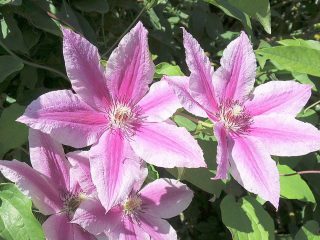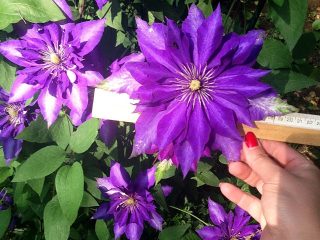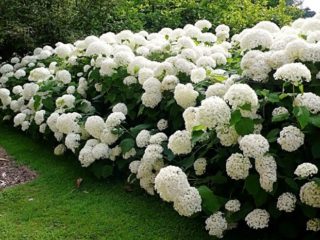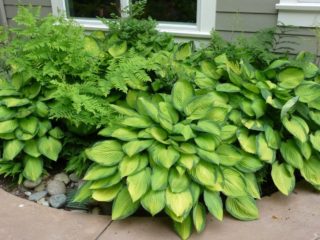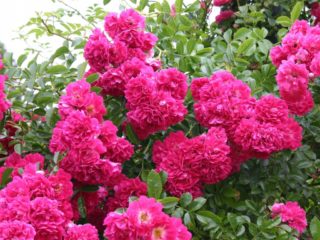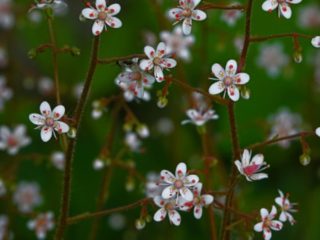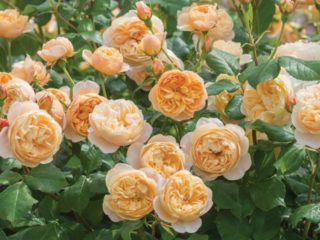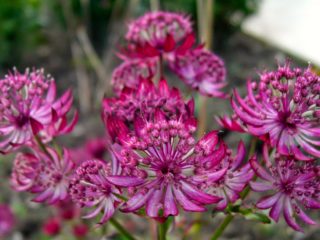Content
Anthemis is an annual and perennial flowering plant, common in Europe, Asia, the Caucasus, Siberia and some places in the Mediterranean. Other names for the flower are navel, chamomile. The culture is a representative of the Compositae family. The photo and description of the navel indicate its similarity to chamomile, although they are not related plants. The culture easily adapts to different climates and tolerates transplantation well, even in flowering form. It is widely used in landscape design and can revive any unsightly areas of the garden.
Description of the navel with photo
The navel, or anthemis, is a herbaceous plant. Under favorable conditions, the culture grows in the form of a subshrub. Stems are thin, erect, slightly branched. Their height is 10-100 cm (depending on the type of crop). The shoots remain green throughout the season.The root system is taprooted and well developed. Thanks to this, the plant is able to tolerate prolonged drought.

Antemis has a long flowering period
The leaves are pinnately dissected, alternately arranged on the stems, and sessile. They are bright green in color and covered with short hairs. The flowers of the navel are single, apical, basket-shaped. They appear on the main stem and side shoots. The marginal flowers are white, pink, yellow, lilac, and the central tubular ones are predominantly golden and orange. The diameter of the buds when fully opened reaches 4 cm. The flowering period of the anthemis begins in May-June and continues until the end of summer.
The leaves and buds of the plant exude aroma. In most types of culture it is pleasant, floral with a small amount of bitterness. But the stinking navel has a specific smell that does not cause positive feelings, which was the name of the species.
After pollination of anthemis flowers, obovate-shaped achenes are formed. When fully ripe, they crack and the seeds fall down to the ground.

The navel is prone to self-seeding
Types and varieties of navel
In nature, there are about two hundred species of navel. Many of them are considered weeds, and only a few have gained popularity due to their high decorative value. Therefore, in order not to make a mistake when choosing a plant for landscaping a site, you need to consider the most popular types of anthemis and study their characteristics.
Dying navel (yellow, yellow-flowered, dyeing anthemis)
This variety of crop belongs to the category of perennials, but it is recommended to grow it as a biennial.The tinker's button (Anthemis tinctoria L.) looks like a highly branched bush, about 40 -70 cm high. The leaves and shoots of the plant have a short edge, which gives them a bluish tint.

The dye's navel blooms in the second year
The inflorescences are large, monochromatic, yellow and terracotta. They emit a pleasant aroma that can be felt even at a distance from the plant. The pedicels of the species are elongated. The corollas of the central tubular petals are in the form of a flattened tube. Each flower has 5 stamens.
In the old days, the flowers of this plant variety were used to dye fabric a lemon-yellow hue. The dyeing button has also found application in gardening. In nature, the species is found in fields, steppes, and hills. Based on it, many decorative varieties were bred.
Among them:
- Grillah Gold. A perennial variety that produces large inflorescences of a rich yellow hue. The shape of the leaves resembles a fern, and their color is bright green. The flowering period begins in the first ten days of June and continues until September.
- Kalwayi. A medium-sized perennial variety, the height of its shoots varies from 30 to 60 cm. It blooms profusely for four weeks. This period begins at the beginning of summer. The color of the flowers is rich yellow. The characteristics of this variety of dyeing navel allow it to be grown in different climatic zones.
- Susanna Mitchell. A short English hybrid, the height of which is 15-30 cm. It has pinnately dissected leaves with a silvery tint. Flowering begins at the end of April and continues until autumn. The marginal petals of the buds are cream, and the central ones are bright yellow.
Stinky navel (dog)
This type of crop is annual.The dog's navel (Anthemis cotula) is distinguished by erect, highly branched shoots. They alternately bear narrow sessile leaves, about 2 mm wide. The plates of the stinking navel are pointed and can be jagged or solid. The annual roots are numerous, thread-like, penetrating into the deep layers of the soil and allowing it to survive during periods of drought.
The annual flowers are small, the edge petals are white and the central petals are yellow. Buds are single, apical. Male and female flowers are produced on the same plant. The flowering period begins in June and continues until August. The plant grows in nature on roadsides, vacant lots, clearings, and near fences. The leaves and flowers of the species emit a specific unpleasant odor, but the plant is medicinal and has found use in folk medicine.

The fruits of the stinking navel begin to ripen in mid-summer
Mayweed
A squat type of crop, the height of its shoots is 20-40 cm. The stems of the field navel (Anthemis arvensis L.) are covered with short, soft light hairs. The leaves are lanceolate, consist of several lobes, and are dark green in color. The inflorescences are 3-4 cm in diameter. Their center is bright yellow, and the marginal petals are snow-white. The flowering period lasts a month, starting in mid-June. The plant grows in clearings, meadows, and fields. It has medicinal properties.

Field navel can grow in the shade
Russian navel
This is an annual plant with highly branched stems at the base. Its height reaches 20-40 cm. The leaf blades of the Russian navel (Anthemis ruthenica Bieb) are narrow, oblong, dark green in color. The flowers are small, no more than 2 cm in diameter, white-yellow. Russian navel blooms in June and continues until the end of August.The species is found in wastelands and populated areas.

Russian navel can grow on any soil
Navel nobilis (Roman chamomile)
A perennial variety of anthemis with straight, weakly branching shoots. The plant is low-growing and tolerates low temperatures well. Creeping type roots. The stems of the noble navel (Anthemis nobilis) are grooved, erect, 30 cm high. The shoots are covered with small hairs. Leaves are lanceolate, pointed.
The flowers are small, double, 2.5-3 cm in diameter. They are white and have a yellowish tint only in the center. The fruits are in the form of round ribbed boxes. Roman chamomile blooms in mid-summer.

The noble navel reacts poorly to stagnant moisture in the soil
Hybrid navel
This is a perennial variety of the crop with a height of 60 cm. The growth diameter of the hybrid navel (Anthemis hybrida) is 50 cm. The leaves are finely dissected and bright green in color. The inflorescences are single, 4 cm in diameter. Their color can be lemon or white-yellow. The hybrid navel blooms in mid-June and continues until late autumn. The species does not occur in nature, as it was obtained as a result of selection.

The hybrid navel is more demanding in terms of care
Planting navel in open ground
Planting anthemis does not cause any particular difficulties. In order for a plant to delight with abundant flowering, it is necessary to correctly select the optimal place for it in the garden and carry out the procedure taking into account the basic requirements of the crop.
Despite the fact that many types of navel are able to tolerate partial shade, the plant still develops better in open sunny areas. The crop cannot be planted in lowlands where water stagnates after rain, as well as in places with groundwater less than 1.5 m.
Antemis does not place high demands on the soil and is able to grow in depleted soil. But the best option for it is sandy and loamy soil with high moisture and air permeability.
You can plant a perennial navel in a permanent place in spring and autumn, and an annual flower in May, when the threat of return frosts has passed. Two weeks before the procedure, it is recommended to dig up the area, add sand if the soil is not loose enough, as well as a little humus. It is necessary to plant navel seedlings at a distance of 20-40 cm. It is recommended to make the holes 20 by 20 cm in size. A drainage layer must initially be laid at the bottom, and then sprinkled with substrate. When planting, the root collar of the plants should be at soil level. And at the end of it, the anthemis needs to be watered well.
Navel care
This garden plant will not cause much trouble for the gardener, since it requires minimal care. It is recommended to water the navel only during periods of prolonged heat. Moisturizing should be done in the evening using settled water. Watering is especially important during the period of bud formation, which will extend the flowering period. The rest of the time the plant can do without it.
Immediately after planting the seedlings, it is recommended to shorten its shoots to a height of 10 cm. This promotes the growth of the crop and ensures abundant flowering. Periodically, you should loosen the soil at the base of the anthemis and remove growing weeds. Subsequently, the culture will be able to independently suppress their growth.
The navel can completely manage without fertilizing.But experienced gardeners recommend fertilizing it with wood ash 1-2 times per season. The product must be scattered around the plant and then embedded in the ground.
In winter, the upper part of the plant dies off. The crop does not need insulation for the winter. It tolerates temperatures well down to -25-30 degrees.

Antemis can grow in one place for 5-6 years without losing its decorative effect
Reproduction methods
The navel reproduces well. To renew the plant and obtain new seedlings, you can use cuttings, dividing the bush and seeds. Each of these methods has its own characteristics that are worth paying attention to.
Growing from seeds
The seed growing method makes it possible to obtain many seedlings at the same time. However, it is recommended for hybrid varieties, since grown seedlings do not retain their species properties.
Sowing should be done at home with seedlings or directly in open ground. In the first case, planting is recommended in early March in wide containers filled with loose substrate. The navel seeds need to be spread on the surface of the soil, then sprinkled with a thin layer of soil and well moistened with a spray bottle. After this, the container must be covered with film and placed in a warm, dark place until shoots appear.
The seeds of the plant germinate in 7-10 days. After this, the container should be transferred to a bright windowsill. Caring for navel seedlings involves moderate watering and periodic spraying. When the seedlings grow up, they need to be planted in separate pots. You can transfer seedlings to open ground when the threat of return frosts has passed.
In the second case, you can sow navel seeds directly into the garden bed. To do this, you need to level the surface, plant in a row, sprinkle with soil and cover the area with agrofibre until shoots appear. Subsequently, when the plants grow up, they need to be planted in the garden.

Anthemis seeds retain high germination rate for two years
Dividing the bush
This is the easiest way to propagate a crop. It is recommended to use it in early autumn. To do this, you need to dig up the common navel and any other type of crop completely, lightly clean its rhizome from the soil, and then divide it with a knife or pruning shears into several parts with well-developed roots.
After the procedure, the divisions should be immediately planted in a permanent place and watered abundantly. Rooting of the navel occurs within two to three weeks.
Cuttings
This method of propagation is suitable only for perennial species of navel. It should be applied in May-June before the crop begins to flower. To do this, you need to cut the apical cuttings, 8-10 cm long, and plant them in a moist, loose substrate, watering them with Kornevin’s solution. To successfully root the seedlings, you need to build a mini-greenhouse over them, ventilating it daily. When the cuttings take root, which happens after 2-3 weeks, they need to be adapted to the external environment and the cover removed.
You can transplant young plants to a permanent place at the end of summer or next spring.
Diseases and pests
The navel has high natural immunity. Therefore, the plant is not affected by fungal diseases, but during prolonged rainy weather it may suffer from root rot.Therefore, under unfavorable conditions, for the purpose of prevention, the plant must be watered with the fungicide Maxim.
Slugs can cause damage to the navel. They prefer to feed on its young leaves and flowers. Mollusks are nocturnal, which makes controlling them difficult. The presence of slugs in the garden bed is indicated by damaged parts of plants and a shiny mark on the soil surface that they leave as they move. To combat them, you need to use metaldehyde-based preparations, scattering granules between plants.
Application in landscape design

Many types of anthemis have found application in landscape design
Its varieties are excellent for creating spectacular borders, rocky gardens, and rock gardens.

The plant looks good in mono- and mixed plantings
The best neighbors for a belly button:
- peonies;
- irises;
- hosts;
- aquilegia;
- Snapdragon.

Antemis is also suitable for cutting and creating dry bouquets
Conclusion
After studying the photo and description of the navel, we can confidently recommend this crop to novice gardeners. After all, this plant is characterized by increased endurance and is ready to forgive many mistakes in care. The main thing is to choose the right place for it on the site and periodically replant it in a new place in order to maintain the annual abundant flowering.



